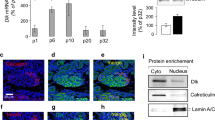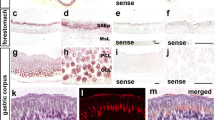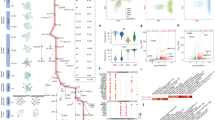Abstract
The Dickkopf (Dkk) gene family of secretory modulators of canonical Wnt/beta catenin signals is involved in the control of stem cell proliferation, homeostasis and differentiation. Bioinformatic data on dkk-1/3 gene expression, indicating high expression levels in the human pancreas, led us to analyze these two proteins in adult human pancreatic tissue. Dkk-1/3 mRNA levels and protein distribution were analyzed in isolated human islets vs. the exocrine/ductal pancreatic cells and in paraffin sections of adult human pancreata. Using real time PCR only lowest amounts of dkk-1 mRNA were detectable in the endocrine fractions. Immunohistochemistry did not reveal any Dkk-1 protein in adult human pancreatic tissue. Interestingly, Dkk-3 mRNA and protein were clearly present in adult human pancreatic islets. Messenger RNA levels for Dkk-3 were significantly higher in isolated islets as compared to the exocrine/ductal fraction. Co-staining with an antibody against insulin identified the beta cells of the pancreas as the Dkk-3-positive cells. Notably, only a subset of beta cells contained Dkk-3. As shown by western blot analysis Dkk-3 seems to be proteolytically processed in beta cells. To our knowledge, this is the first study describing a molecule with which the pool of pancreatic beta cells can be further subdivided. Future studies will show whether this sub-classification of beta cells translates into functional differences.







Similar content being viewed by others
References
Bernard N, Kitabgi P, Rovere-Jovene C (2003) The Arg617–Arg618 cleavage site in the C-terminal domain of PC1 plays a major role in the processing and targeting of the enzyme within the regulated secretory pathway. J Neurochem 85:1592–1603
Byun T, Karimi M, Marsh JL, Milovanovic T, Lin F, Holcombe RF (2005) Expression of secreted Wnt antagonists in gastrointestinal tissues: potential role in stem cell homeostasis. J Clin Pathol 58:515–519
Davidson G, Mao B, Del BB I, Niehrs C (2002) Kremen proteins interact with Dickkopf1 to regulate anteroposterior CNS patterning. Development 129:5587–5596
Del BB I, Montero-Pedrazuela A, Guadano-Ferraz A, Obregon MJ, Martinez dM, Gailus-Durner V, Fuchs H, Franz TJ, Kalaydjiev S, Klempt M, Holter S, Rathkolb B, Reinhard C, Morreale dE, Bernal J, Busch DH, Wurst W, Wolf E, Schulz H, Shtrom S, Greiner E, Hrabe dA, Westphal H, Niehrs C (2006) Generation and characterization of dickkopf3 Mutant Mice. Mol Cell Biol 26:2317–2326
Dor Y, Brown J, Martinez OI, Melton DA (2004) Adult pancreatic beta-cells are formed by self-duplication rather than stem-cell differentiation. Nature 429:41–46
Etheridge SL, Spencer GJ, Heath DJ, Genever PG (2004) Expression profiling and functional analysis of wnt signaling mechanisms in mesenchymal stem cells. Stem Cells 22:849–860
Glinka A, Wu W, Delius H, Monaghan AP, Blumenstock C, Niehrs C (1998) Dickkopf-1 is a member of a new family of secreted proteins and functions in head induction. Nature 391:357–362
Gregory CA, Singh H, Perry AS, Prockop DJ (2003) The Wnt signaling inhibitor dickkopf-1 is required for reentry into the cell cycle of human adult stem cells from bone marrow. J Biol Chem 278:28067–28078
Heller RS, Klein T, Ling Z, Heimberg H, Katoh M, Madsen OD, Serup P (2003) Expression of Wnt, Frizzled, sFRP, and DKK genes in adult human pancreas. Gene Expr 11:141–147
Hermann M, Pirkebner D, Draxl A, Margreiter R, Hengster P (2005) In the search of potential human islet stem cells: is tetranectin showing us the way? Transplant Proc 37:1322–1325
Horwitz EM (2004) Dkk-1-mediated expansion of adult stem cells. Trends Biotechnol 22:386–388
Kawano Y, Kitaoka M, Hamada Y, Walker MM, Waxman J, Kypta RM (2006) Regulation of prostate cell growth and morphogenesis by Dickkopf-3. Oncogene
Krupnik VE, Sharp JD, Jiang C, Robison K, Chickering TW, Amaravadi L, Brown DE, Guyot D, Mays G, Leiby K, Chang B, Duong T, Goodearl AD, Gearing DP, Sokol SY, McCarthy SA (1999) Functional and structural diversity of the human Dickkopf gene family. Gene 238:301–313
Kuhnert F, Davis CR, Wang HT, Chu P, Lee M, Yuan J, Nusse R, Kuo CJ (2004) Essential requirement for Wnt signaling in proliferation of adult small intestine and colon revealed by adenoviral expression of Dickkopf-1. Proc Natl Acad Sci USA 101:266–271
Kume S (2005) The molecular basis and prospects in pancreatic development. Dev Growth Differ 47:367–374
Mao B, Niehrs C (2003) Kremen2 modulates Dickkopf2 activity during Wnt/LRP6 signaling. Gene 302:179–183
Mao B, Wu W, Davidson G, Marhold J, Li M, Mechler BM, Delius H, Hoppe D, Stannek P, Walter C, Glinka A, Niehrs C (2002) Kremen proteins are Dickkopf receptors that regulate Wnt/beta-catenin signalling. Nature 417:664–667
Niehrs C (2006) Function and biological roles of the Dickkopf family of Wnt modulators. Oncogene 25:7469–7481
Pfaffl MW (2001) A new mathematical model for relative quantification in real-time RT-PCR. Nucleic Acids Res 29:e45
Ricordi C, Lacy PE, Finke EH, Olack BJ, Scharp DW (1988) Automated method for isolation of human pancreatic islets. Diabetes 37:413–420
Semenov MV, Tamai K, Brott BK, Kuhl M, Sokol S, He X (2001) Head inducer Dickkopf-1 is a ligand for Wnt coreceptor LRP6. Curr Biol 11:951–961
Tsuji T, Miyazaki M, Sakaguchi M, Inoue Y, Namba M (2000) A REIC gene shows down-regulation in human immortalized cells and human tumor-derived cell lines. Biochem Biophys Res Commun 268:20–24
Tsuji T, Nozaki I, Miyazaki M, Sakaguchi M, Pu H, Hamazaki Y, Iijima O, Namba M (2001) Antiproliferative activity of REIC/Dkk-3 and its significant down-regulation in non-small-cell lung carcinomas. Biochem Biophys Res Commun 289:257–263
van Tilbeurgh H, Bezzine S, Cambillau C, Verger R, Carriere F (1999) Colipase: structure and interaction with pancreatic lipase. Biochim Biophys Acta 1441:173–184
Wu W, Glinka A, Delius H, Niehrs C (2000) Mutual antagonism between dickkopf1 and dickkopf2 regulates Wnt/beta-catenin signalling. Curr Biol 10:1611–1614
Acknowledgments
We gratefully acknowledge the support provided by Allianz Elementar Versicherungs-AG.
Author information
Authors and Affiliations
Corresponding author
Electronic supplementary material
Below is the link to the electronic supplementary material.
ESM1 (WMV 246 kb)
ESM2 (WMV 174 kb)
Rights and permissions
About this article
Cite this article
Hermann, M., Pirkebner, D., Draxl, A. et al. Dickkopf-3 is expressed in a subset of adult human pancreatic beta cells. Histochem Cell Biol 127, 513–521 (2007). https://doi.org/10.1007/s00418-007-0278-6
Accepted:
Published:
Issue Date:
DOI: https://doi.org/10.1007/s00418-007-0278-6




